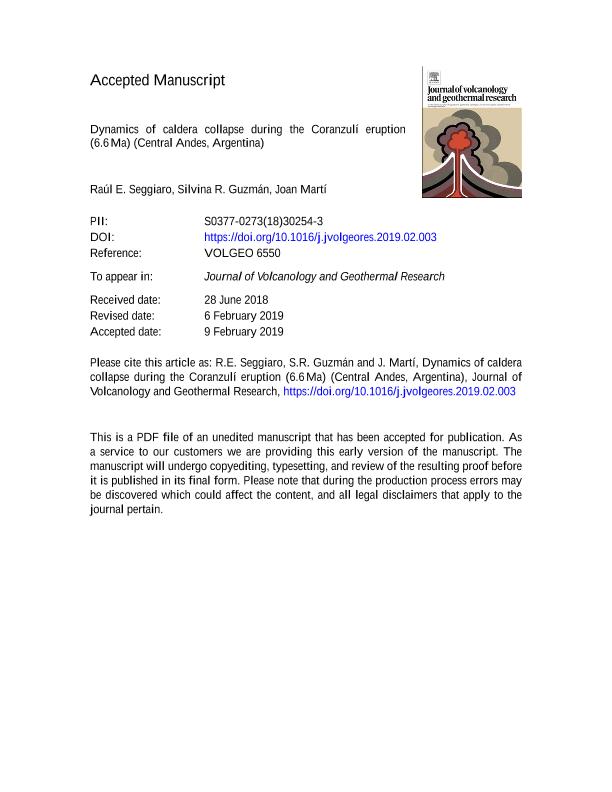Mostrar el registro sencillo del ítem
dc.contributor.author
Seggiaro, Raul Eudocio

dc.contributor.author
Guzman, Silvina Raquel

dc.contributor.author
Martí, Joan
dc.date.available
2020-12-17T03:34:58Z
dc.date.issued
2019-04
dc.identifier.citation
Seggiaro, Raul Eudocio; Guzman, Silvina Raquel; Martí, Joan; Dynamics of caldera collapse during the Coranzulí eruption (6.6 Ma) (Central Andes, Argentina); Elsevier Science; Journal of Volcanology and Geothermal Research; 374; 4-2019; 1-12
dc.identifier.issn
0377-0273
dc.identifier.uri
http://hdl.handle.net/11336/120683
dc.description.abstract
The Coranzulí caldera (23°00′ S ? 66°15′ W) is one of the least known caldera complexes in the eastern part of the Argentinian Altiplano-Puna plateau (Central Andes). It lies at the intersection of N S, NW-SE and NE-SW fault systems and was formed about 6.6Ma ago; during the eruption, four main crystal-rich daciticignimbrites were emplaced in different directions around the caldera. Caldera collapse was not homogeneous, rather it occurred along different sectors of the ring fault as subsidence progressed. The location of co-ignimbrite lag breccias and the composition of the dominant lithic fragments within the different ignimbrite flow units reveal how the caldera collapse developed. According to the succession of deposits, in particular the lack of an initial fallout and the presence of co-ignimbrite lag breccias associated with the different ignimbriteunits, we interpret this caldera-forming eruption as a pulsating boiling-over event in which the caldera collapse developed immediately after the onset of the eruption, favored by a transtensive tectonic system. Within the central part of the caldera, there is Cerro Coranzulí, a resurgent dome that exposes a thick intracaldera ignimbrite succession covered by ~ 100-m-thick dacite lava flows that erupted at the end of caldera formation.
dc.format
application/pdf
dc.language.iso
eng
dc.publisher
Elsevier Science

dc.rights
info:eu-repo/semantics/openAccess
dc.rights.uri
https://creativecommons.org/licenses/by-nc-sa/2.5/ar/
dc.subject
ALTIPLANO-PUNA VOLCANIC COMPLEX
dc.subject
CALDERA
dc.subject
CENTRAL ANDES
dc.subject
CORANZULÍ
dc.subject
CRYSTAL-RICH IGNIMBRITE
dc.subject
PUNA
dc.subject.classification
Vulcanología

dc.subject.classification
Ciencias de la Tierra y relacionadas con el Medio Ambiente

dc.subject.classification
CIENCIAS NATURALES Y EXACTAS

dc.title
Dynamics of caldera collapse during the Coranzulí eruption (6.6 Ma) (Central Andes, Argentina)
dc.type
info:eu-repo/semantics/article
dc.type
info:ar-repo/semantics/artículo
dc.type
info:eu-repo/semantics/publishedVersion
dc.date.updated
2020-11-20T17:43:16Z
dc.journal.volume
374
dc.journal.pagination
1-12
dc.journal.pais
Países Bajos

dc.journal.ciudad
Amsterdam
dc.description.fil
Fil: Seggiaro, Raul Eudocio. Secretaría de Industria y Minería. Servicio Geológico Minero Argentino; Argentina. Consejo Nacional de Investigaciones Científicas y Técnicas. Centro Científico Tecnológico Conicet - Salta. Instituto de Bio y Geociencias del NOA. Universidad Nacional de Salta. Facultad de Ciencias Naturales. Museo de Ciencias Naturales. Instituto de Bio y Geociencias del NOA; Argentina
dc.description.fil
Fil: Guzman, Silvina Raquel. Consejo Nacional de Investigaciones Científicas y Técnicas. Centro Científico Tecnológico Conicet - Salta. Instituto de Bio y Geociencias del NOA. Universidad Nacional de Salta. Facultad de Ciencias Naturales. Museo de Ciencias Naturales. Instituto de Bio y Geociencias del NOA; Argentina
dc.description.fil
Fil: Martí, Joan. Consejo Superior de Investigaciones Científicas. Instituto de Ciencias de la Tierra Jaume Almera; España
dc.journal.title
Journal of Volcanology and Geothermal Research

dc.relation.alternativeid
info:eu-repo/semantics/altIdentifier/url/https://linkinghub.elsevier.com/retrieve/pii/S0377027318302543
dc.relation.alternativeid
info:eu-repo/semantics/altIdentifier/doi/http://dx.doi.org/10.1016/j.jvolgeores.2019.02.003
Archivos asociados
